|
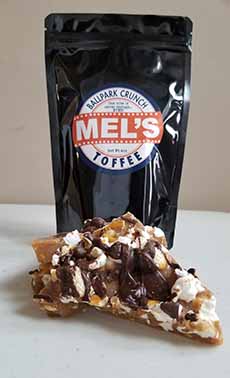
[1] Ballpark Crunch Toffee adds peanuts and popcorn (all photos © Mel’s Toffee except as noted).

[2] Maple Bourbon Pecan Toffee was a winner in the International Toffee Competition and a judge’s favorite in the International Chocolate Salon.
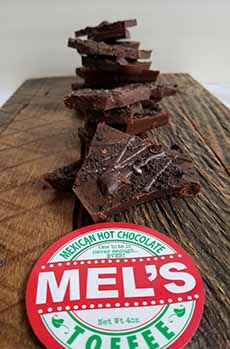
[3] Mexican Hot Chocolate Toffee is our personal favorite, for the zinginess of the cinnamon and jalapeño. Sweet heat is a great combination.
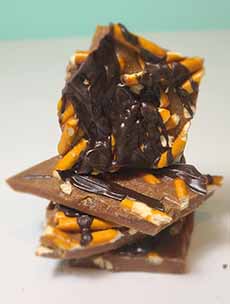
[4] Sea Salt Pretzel Toffee is another inspired combination: sweet, salty, crunchy.
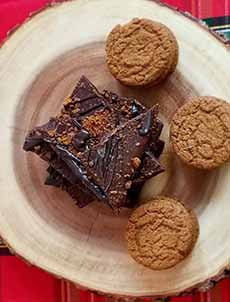
[5] Gingerbread Crunch Toffee is a seasonal special.
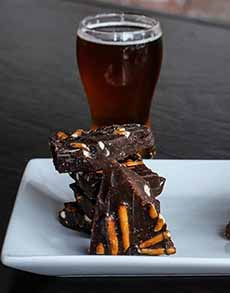
[6] Following the lead of some Michigan craft breweries, we conducted our own toffee-and-beer tasting.

[7] We laid out six flavors, and brought out the beers (photo © The Nibble).
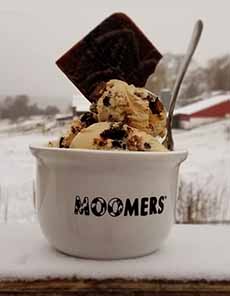
[8] The toffee is also used by an artisan ice cream maker, Moomers.
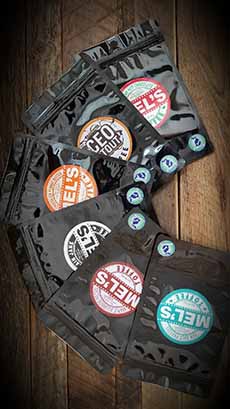
[9] It’s tough to make a decision. Try them all!
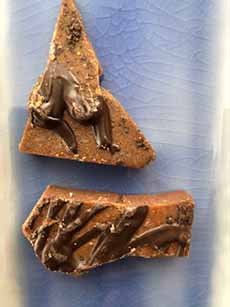
[10] CEO Stout Toffee (photos #10 and #11 © The Nibble).
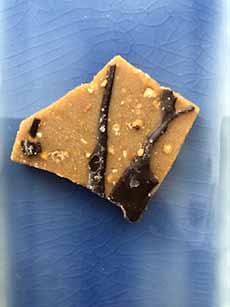
[11] Peanut Butter Toffee.
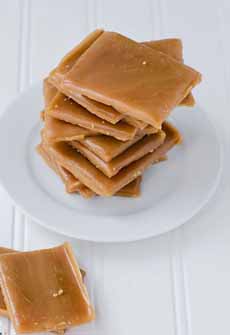
[12] Classic toffee, originating in England, is often called English toffee in the U.S. It does not contain nuts or a chocolate coating (photo © Bakingdom).
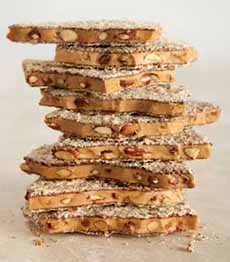
[13] Classic buttercrunch (also called almond buttercrunch), invented in the U.S., contains both nuts and a chocolate cloak. Most American producers erroneously call it toffee. Even our favorite producer, Enstrom, calls it toffee (photo © Enstrom).
|
|
Our Top Pick this week is a delightful line of flavored toffee from Mel’s Toffee, an award winning Michigan Made Toffee company.
The artisan, small batch toffee is made in Metro Detroit, and has become so popular with other Michigan artisans that it’s been used in artisan ice cream.
More unusual—and delightful—local breweries have held toffee and beer tastings with their craft beers.
We love toffee, and couldn’t wait to taste the flavors.
We even held our own beer and toffee tasting. The pairings are below.
And, the history of toffee, and the differences between English toffee, American toffee, buttercrunch, butterscotch and caramel are below.
Here are:
> The year’s 60+ candy holidays.
> The year’s 69 chocolate holidays.
> The year’s 38 nut holidays.
> The history of candy.
> The history of chocolate.
Below:
> The history of toffee.
> The difference between American buttercrunch and English toffee.
> The difference between brittle, buttercrunch, butterscotch, caramel, and toffee.
MEL’S TOFFEE DELIGHTS
The best toffee—the best anything—starts with the best ingredients: butter, sugar, chocolate, cocoa powder, almonds, pecans, peanuts, craft beer.
The ingredients speak for themselves.
If you think “peanuts are peanuts,” for example: There’s a big difference between peanuts from small producers and peanuts from mass growers…well, think of an apple pie from a fine bakery versus one from the supermarket.
Toffee comes under the “what’s not to like?” category, unless your teeth don’t like the hard toffee sticking in your teeth and threatening your fillings.
Mel’s Toffee works around that issue, using beet sugar instead of cane sugar as the sweetener.
When you crunch into it, it yields to your teeth and the “stick-to-them” factor is minimal.
MEL’S TOFFEE FLAVORS
Mel’s makes “toffee with a twist.” The twist is the variety of delicious flavors, that gives each flavor a distinct personality.
Mel’s decided to drizzle chocolate on top of the toffee, rather than enrobe each piece in chocolate.
The approach makes the different flavors in the toffee stand out.
We’ve included our beer pairings along with the flavors:
Ballpark Crunch Toffee, with popcorn, peanuts and pretzels [paired with lager]
CEO Stout Toffee, with espresso stout [paired with coffee stout]
Maple Bourbon Pecan Toffee, with bourbon and pecans [paired with bourbon and soda]
Mexican Hot Chocolate Toffee, with Saigon cinnamon and jalapeño [paired with IPA]
Peanut Butter Toffee, with salty Virginia peanuts [paired with porter]
Plain Jane Toffee, the basic [paired with dark ale]
Sea Salt Pretzel Toffee, a sweet and salty delight [paired with lager]
Seasonal Specials, like Gingerbread Crunch Toffee for the holidays—we can’t wait! [we’d pair it with an American IPA]
Note that the alcohol pairings are our own choices. Brewers and beer experts may make different ones.
GET YOUR TOFFEE!
Head to Mel’s Toffee.
Quarter-pound bags are $7.25. In addition to treating yourself, think of them as stocking stuffers and party favors.
ABOUT MEL’S TOFFEE
Michelle Williamson, who had previously worked in fine dining restaurants, was a stay-at-home mom in the greater Detroit area.
When her two daughters went off to preschool, she began exploring what kind of food business she could create.
After experimenting with chocolates, truffles, barks, turtles, chocolate-covered pretzels and specialty cookies, she decided to focus on toffee, and Mel’s Toffee was launched.
The company name is a combination of her first initial and those of her daughters. Her husband’s initial didn’t fit in, so he is known as “the silent partner.”
THE HISTORY OF TOFFEE
Most food historians agree that toffee is a creation of Great Britain, in the early 1800s.
In dairying countries like England, butter was plentiful and sugar had become affordable.
The result: toffee making (along with fudge, caramels, and other candies).
The Oxford English Dictionary first mentions the word “toffee” in 1825.
Since words were in use for some time before they were acknowledged in a dictionary, that’s what points to the early 1800s for the appearance of toffee.
The origin of the word toffee is not certain. Some believe it to be a form of the word “tafia,” a West Indies rum distilled from molasses.
Possibly, the toffee, which is still made with molasses by some producers in the England, could have been made from the molasses syrup skimmed off the liquor during distillation. (Modern toffee is made with caramelized sugar and butter.)
But follow the trail after that, and the descriptions get confusing, as you’ll see in the next section, “The Difference.”
These things everyone will agree upon:
Toffee is a hard, chewy candy made by combining some type of sugar (white, brown, molasses, treacle), plus butter.
American recipes for “English toffee” often add vanilla and/or other flavorings, and can also add milk or cream (which makes the toffee softer).
The ingredients are boiled together at a high temperature, until the mixture is golden brown and stiff.
The toffee is then spread into a shallow pan or onto a surface to thicken and cool.
The slab is then broken into smaller, irregular pieces. Some toffees are poured into molds, typically to produce neat square shapes.
To get an idea of the consistency of toffee, think of the center of a Heath bar‡ (which is actually American buttercrunch, a confection that adds nuts and chocolate to a center of toffee).
THE DIFFERENCE BETWEEN AMERICAN BUTTERCRUNCH & ENGLISH TOFFEE
Brits make toffee with white or brown sugar, molasses or treacle. The latter three creates a darker flavor, and molasses and treacle deepen the color as well.
Americans tend to use white sugar, which brings out the buttery qualities (although some American candy makers add some or all brown sugar).
There is no “American toffee,” per se. This exists only when a producer in America is making English toffee.
In fact, “toffee” is one of the most mis-used food words in America.
Other sources say that English toffee is hard, and American toffee is somewhat softer. In some cases, depending on the producer.
American-style toffee, with chopped almonds mixed into the toffee and then rolled in crushed almonds, is called buttercrunch, and it is coated with chocolate*.
Thus, to be accurate:
Toffee or English toffee: Butter + sugar + water + sometimes other ingredients like treacle (photo #12).
Buttercrunch or almond buttercrunch: Butter + sugar + water + almonds + chocolate (photo #13).
“Buttercrunch toffee” is an inaccurate term: It’s either one or the other.
The term “English toffee” doesn’t exist in the U.K.: Toffee is de facto English. English toffee is made in a range of textures from chewy to hard, and variations like butter toffee and treacle toffee.
“English toffee” in the U.S. refers to the traditional British hard toffee style, which is the base for buttercrunch.
Butter toffee (England) is made primarily with butter, sugar, and water and has a rich, creamy, buttery flavor and a hard and brittle texture. It’s golden to medium brown in color and generally considered a more refined or premium style.
Treacle toffee (England) is made with black treacle (similar to blackstrap molasses), along with sugar and butter or margarine. The treacle gives it a distinctive, robust molasses flavor, a darker color (deep brown to nearly black) and a more intense, slightly bitter-sweet flavor. It’s often harder and more brittle than butter toffee.
Treacle toffee is also called “bonfire toffee” or “plot toffee” and is popular on Guy Fawkes Night, November 5th, which commemorates the foiling of the Gunpowder Plot in 1605, when Guy Fawkes and co-conspirators tried to blow up Parliament. The British celebrate with fireworks and bonfires, burning effigies of Guy Fawkes. Treacle toffee’s nearly black appearance may symbolically connect to the dark plot, gunpowder, and/or the charred remains of the bonfire.
NAME CONFUSION
Yet, many producers of buttercrunch call their products “toffee” or “almond toffee”—or worse, English toffee. Who wouldn’t be confused?
Here’s the scoop:
Classic English toffee is unadorned. If it’s covered with chocolate, it’s American style toffee; if nuts are added, it’s buttercrunch.
So why do producers of American-style toffee insist on calling it “English toffee” when it isn’t?†
Our guess is ignorance, or because they think it will sell better.
Are people entitled to call things what they want?
There is no legal definition (here’s what exists from the USDA), but it’s like calling an apple tart, which is made in a particular type of pan, to an apple galette, which has a free-form (hand-shaped, no pan) crust.
And it’s confusing and misleading to the consumer…but at this point, it’s a losing battle.
There are numerous candies on the market called “toffee” that are actually caramel.
More than a few caramel apples are called “toffee apples.” Feel free to point out to the seller that if, in fact, there were toffee on the apples, you wouldn’t be able to bite into them.
THE DIFFERENCE: CARAMEL, BUTTERSCOTCH, TOFFEE, BRITTLE
These candies are related, but differ in hardness and other features.
Caramels are the softest of this group of candies, butterscotch is harder and toffee is the hardest.
This is based on both ingredients and at how high a temperature the ingredients are boiled.
Here’s a comparison:
Butterscotch and toffee are made by combining sugar, butter and water. Classic English toffee has no other ingredients than those—no vanilla, no chocolate, no nuts.
Butter toffee is a redundant term: Toffee is made with butter, except in situations where mass marketers substitute cheaper fats.
Butterscotch and American-style toffee, as opposed to English toffee, add vanilla and other flavorings.
Butterscotch is then boiled to the soft-crack stage (270°F to 290°F on a candy thermometer), toffee to a hard-crack (295°F to 310°F).
Toffee is boiled to to a hard-crack (295°F to 310°F).
Toffee is made in a slab and broken up with a hammer. It can also be made in a mold, typically to produce square individual portions that are then enrobed in chocolate.
Brittle is a mixture of sugar and water, embedded with nuts. Like toffee, it is heated to the hard crack stage—the highest temperature at which candy is made candy (295°F to 310°F). The difference is that toffee includes butter.
Caramels add milk or cream (and sometimes, flavors) and are cooked at a lower heat, to the firm-ball stage (248°F). Both of these factors make them softer and chewier. If it’s soft, it’s caramel.
________________
*The first well-known brand was Almond Roca, launched in 1923 by Brown & Hale of Tacoma, Washington. Roca means “rock” in Spanish. In those days, most almonds came from Spain, and the name suited the crunchy (“rock-like”)center. The name may have been coined by William Loft, who began a confectionery in 1860 and sold almond-coated toffee (alas, the business closed in the 1990s).
†Some American producers may in fact make English-style toffee; but most of what we’ve seen called English toffee, isn’t.
‡The full name of this popular newsstand candy bar is Heath Milk Chocolate English Toffee Bar. It’s made of toffee, almonds and milk chocolate. It was first made by the Heath brothers in Robison, Illinois in 1928 (the brand is now owned by the Hershey Corporation).
|















